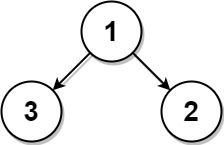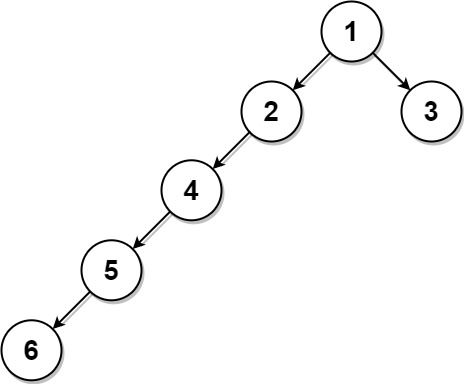Welcome to Subscribe On Youtube
742. Closest Leaf in a Binary Tree
Description
Given the root of a binary tree where every node has a unique value and a target integer k, return the value of the nearest leaf node to the target k in the tree.
Nearest to a leaf means the least number of edges traveled on the binary tree to reach any leaf of the tree. Also, a node is called a leaf if it has no children.
Example 1:

Input: root = [1,3,2], k = 1 Output: 2 Explanation: Either 2 or 3 is the nearest leaf node to the target of 1.
Example 2:

Input: root = [1], k = 1 Output: 1 Explanation: The nearest leaf node is the root node itself.
Example 3:

Input: root = [1,2,3,4,null,null,null,5,null,6], k = 2 Output: 3 Explanation: The leaf node with value 3 (and not the leaf node with value 6) is nearest to the node with value 2.
Constraints:
- The number of nodes in the tree is in the range
[1, 1000]. 1 <= Node.val <= 1000- All the values of the tree are unique.
- There exist some node in the tree where
Node.val == k.
Solutions
DFS & BFS.
-
/** * Definition for a binary tree node. * public class TreeNode { * int val; * TreeNode left; * TreeNode right; * TreeNode() {} * TreeNode(int val) { this.val = val; } * TreeNode(int val, TreeNode left, TreeNode right) { * this.val = val; * this.left = left; * this.right = right; * } * } */ class Solution { private Map<TreeNode, List<TreeNode>> g; public int findClosestLeaf(TreeNode root, int k) { g = new HashMap<>(); dfs(root, null); Deque<TreeNode> q = new LinkedList<>(); for (Map.Entry<TreeNode, List<TreeNode>> entry : g.entrySet()) { if (entry.getKey() != null && entry.getKey().val == k) { q.offer(entry.getKey()); break; } } Set<TreeNode> seen = new HashSet<>(); while (!q.isEmpty()) { TreeNode node = q.poll(); seen.add(node); if (node != null) { if (node.left == null && node.right == null) { return node.val; } for (TreeNode next : g.get(node)) { if (!seen.contains(next)) { q.offer(next); } } } } return 0; } private void dfs(TreeNode root, TreeNode p) { if (root != null) { g.computeIfAbsent(root, k -> new ArrayList<>()).add(p); g.computeIfAbsent(p, k -> new ArrayList<>()).add(root); dfs(root.left, root); dfs(root.right, root); } } } -
/** * Definition for a binary tree node. * struct TreeNode { * int val; * TreeNode *left; * TreeNode *right; * TreeNode() : val(0), left(nullptr), right(nullptr) {} * TreeNode(int x) : val(x), left(nullptr), right(nullptr) {} * TreeNode(int x, TreeNode *left, TreeNode *right) : val(x), left(left), right(right) {} * }; */ class Solution { public: unordered_map<TreeNode*, vector<TreeNode*>> g; int findClosestLeaf(TreeNode* root, int k) { dfs(root, nullptr); queue<TreeNode*> q; for (auto& e : g) { if (e.first && e.first->val == k) { q.push(e.first); break; } } unordered_set<TreeNode*> seen; while (!q.empty()) { auto node = q.front(); q.pop(); seen.insert(node); if (node) { if (!node->left && !node->right) return node->val; for (auto next : g[node]) { if (!seen.count(next)) q.push(next); } } } return 0; } void dfs(TreeNode* root, TreeNode* p) { if (!root) return; g[root].push_back(p); g[p].push_back(root); dfs(root->left, root); dfs(root->right, root); } }; -
# Definition for a binary tree node. # class TreeNode: # def __init__(self, val=0, left=None, right=None): # self.val = val # self.left = left # self.right = right class Solution: def findClosestLeaf(self, root: TreeNode, k: int) -> int: def dfs(root, p): if root: g[root].append(p) g[p].append(root) dfs(root.left, root) dfs(root.right, root) g = defaultdict(list) dfs(root, None) q = deque([node for node in g if node and node.val == k]) seen = set() while q: node = q.popleft() seen.add(node) if node: if node.left is None and node.right is None: return node.val for next in g[node]: if next not in seen: q.append(next) -
/** * Definition for a binary tree node. * type TreeNode struct { * Val int * Left *TreeNode * Right *TreeNode * } */ func findClosestLeaf(root *TreeNode, k int) int { g := make(map[*TreeNode][]*TreeNode) var dfs func(root, p *TreeNode) dfs = func(root, p *TreeNode) { if root == nil { return } g[root] = append(g[root], p) g[p] = append(g[p], root) dfs(root.Left, root) dfs(root.Right, root) } dfs(root, nil) var q []*TreeNode for t, _ := range g { if t != nil && t.Val == k { q = append(q, t) break } } seen := make(map[*TreeNode]bool) for len(q) > 0 { node := q[0] q = q[1:] seen[node] = true if node != nil { if node.Left == nil && node.Right == nil { return node.Val } for _, next := range g[node] { if !seen[next] { q = append(q, next) } } } } return 0 }